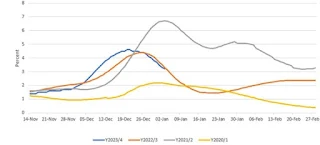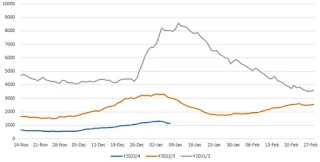JN.1, the covid-19 variant that is dominant in much of the world, is more infectious than its predecessors, but appears to be causing less severe illness
 |
| The JN.1 version of omicron covid-19 variant was first detected in Luxembourg in August (Credit: JUN LI /Getty images) |
Some of the recent news stories about covid-19 have felt reminiscent of the first two years of the pandemic. Due to a variant called JN.1 – sometimes called Juno – infection rates have been rising in many countries, with some initial claims that it could cause more serious illness.
But in fact, the latest figures show that in England’s current wave, people who get infected are substantially less likely to get sick enough to need hospital treatment, compared with previous waves. This suggests that, on average, those who catch covid-19 have less to worry about than at any other time during the pandemic, says Paul Hunter at the University of East Anglia in the UK.
JN.1, another version of the omicron variant, was first detected in Luxembourg in August and spread to numerous countries over the following months. Genetic sequencing showed it was significantly different from most previous versions of omicron and, by November, it became apparent that JN.1 was rapidly taking over.
Those observations led to concerns that JN.1 would cause a large wave of covid-19 over the northern hemisphere’s winter, when hospitals would also be coping with high numbers of people with other seasonal respiratory viruses, such as flu and respiratory syncytial virus (RSV).
In December, claims were made that the JN.1 wave was causing more severe illness, as many people haven’t had a covid-19 vaccine for some time. In the UK and many other European countries, autumn 2023 boosters were only offered to older people or those who met certain criteria, such as being medically vulnerable. Even in countries such as the US, where the vaccines are available to everyone older than 6 months, uptake has been low.
As concerns over JN.1 mounted, there were calls to bring back various public health restrictions against covid-19. Some hospitals in the UK and the US, for instance, have reintroduced face masks in public spaces and last week Spain made mask wearing compulsory in all healthcare settings.
Fortunately, the warnings of a bigger wave haven’t borne out so far. And in England, the current wave is causing less severe illness than ever before, as judged by the number of people the coronavirus is sending to hospital compared with the number who are known to be infected.
 |
| The proportion of people in England estimated to test positive for covid-19 (Credit: Paul Hunter) |
For instance, the number of people testing positive for covid-19 in England amid its current wave seems to have peaked in mid-to-late December, at about 4.5 per cent of the population, according to a large, regular survey by the Office for National Statistics and the UK Health Security Agency. This is a similar proportion to that seen during the covid-19 wave that peaked in December 2022.
 |
| Credit: Paul Hunter |
Yet the number of people being admitted to hospitals in England primarily due to covid-19 seems to have peaked this winter at just over a third of the equivalent figure from the previous year – at about 1300 in early January 2024, compared with around 3300 a year ago. “On average, someone catching covid-19 in this wave is less likely to be admitted to hospital,” says Hunter.
It is unclear whether the fall in severity is because JN.1 is intrinsically milder than other variants or if people just have more immunity to covid-19 now, thanks to past infections and vaccinations, even if they were administered some time ago. “I think immunity is probably playing a big role, but it may be that the latest variant is also less virulent,” says Hunter.
However, even though an infected person’s risk of going to hospital may be lower than last year, the large numbers of people getting infected still adds to winter pressures on hospitals, says Stephen Griffin at the University of Leeds in the UK. “The number of people that end up going into hospital is still considerable.”
Then there is long covid to consider, when people get symptoms such as lasting fatigue, breathlessness and cognitive problems. “These sorts of analyses focus on acute disease and hospitalisations,” says Griffin. “The clinical burden of long covid needs to be considered.” On the other hand, less severe initial illness with covid-19 seems to correlate with a lower chance of lasting symptoms.
Part of the reason the JN.1 variant caused such concern initially was that it is genetically quite different from most previous omicron variants. It was about as big a genetic leap as omicron was compared with the former delta variant, says Michael Fuhrer at Monash University in Melbourne, Australia. “I think people were right to wonder what was going to happen. But now that we’re getting data, it looks like omicron-size jumps are just not the same problem that they were in 2021. That’s really good news.”





0 Comments